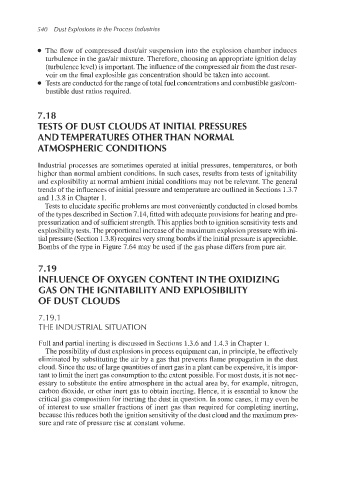Page 573 - Dust Explosions in the Process Industries
P. 573
540 Dust Explosions in the Process Industries
The flow of compressed dust/air suspension into the explosion chamber induces
turbulence in the gadair mixture. Therefore, choosing an appropriate ignition delay
(turbulencelevel) is important.The influenceof the compressed air from the dust reser-
voir on the final explosible gas concentration should be taken into account.
Tests are conducted for the range of total fuel concentrationsand combustiblegashom-
bustible dust ratios required.
7.18
TESTS OF DUST CLOUDS AT INITIAL PRESSURES
AND TEMPERATURES OTHERTHAN NORMAL
ATMOSPHERIC CONDITIONS
Industrial processes are sometimes operated at initial pressures, temperatures, or both
higher than normal ambient conditions. In such cases, results from tests of ignitability
and explosibility at normal ambient initial conditions may not be relevant. The general
trends of the influencesof initial pressure and temperature are outlined in Sections 1.3.7
and 1.3.8 in Chapter 1.
Tests to elucidate specific problems are most conveniently conducted in closed bombs
of the types described in Section 7.14, fitted with adequate provisions for heating and pre-
pressurization and of sufficient strength. This applies both to ignition sensitivity tests and
explosibilitytests. The proportional increase of the maximum explosionpressure with ini-
tial pressure (Section 1.3.8)requiresvery strong bombs if the initial pressure is appreciable.
Bombs of the type in Figure 7.64 may be used if the gas phase differs from pure air.
7.1 9
INFLUENCE OF OXYGEN CONTENT IN THE OXIDIZING
GAS ON THE IGNITABILITY AND EXPLOSlBlLlTY
OF DUST CLOUDS
7.1 9.1
THE INDUSTRIAL SITUATION
Full and partial inerting is discussed in Sections 1.3.6 and 1.4.3 in Chapter 1.
The possibility of dust explosions in process equipment can, in principle, be effectively
eliminated by substituting the air by a gas that prevents flame propagation in the dust
cloud. Sincethe use of large quantities of inert gas in a plant can be expensive, it is impor-
tant to limit the inert gas consumption to the extent possible. For most dusts, it is not nec-
essary to substitute the entire atmosphere in the actual area by, for example, nitrogen,
carbon dioxide, or other inert gas to obtain inerting. Hence, it is essential to know the
critical gas composition for inerting the dust in question. In some cases, it may even be
of interest to use smaller fractions of inert gas than required for completing inerting,
because this reduces both the ignition sensitivityof the dust cloud and the maximum pres-
sure and rate of pressure rise at constant volume.

